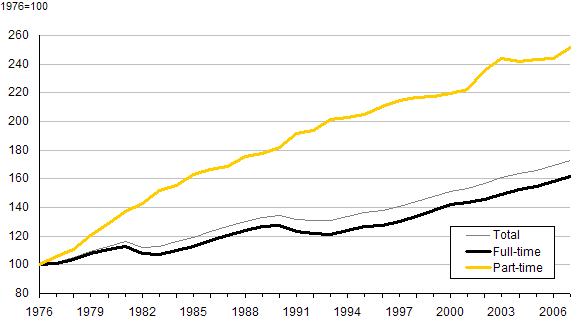Publications
The Canadian Labour Market at a Glance
Employment indexes, by type of work
Archived Content
Information identified as archived is provided for reference, research or recordkeeping purposes. It is not subject to the Government of Canada Web Standards and has not been altered or updated since it was archived. Please "contact us" to request a format other than those available.
Full-time employment growth continued to outpace that for part-time from 2005 to 2007
-
In the last three decades prior to 2005, the number of people working part time increased sharply. The index shows that the number of part-time workers has more than doubled over thirty years, while full-time workers saw just over a 60% increase. In 2007, over three million workers, or nearly one in five worked part time compared with only one in eight in 1976.
-
Following a slow pace of growth in part-time employment from 2003 to 2006, the pace quickened in 2007. However, compared to four years earlier, full-time employment rose by 8.6% in 2007, while part-time increased by 3.2%.
-
Internationally, the Netherlands, Australia, the United Kingdom and Germany all had larger shares of part-time employment in 2007 than Canada. All these countries, with the exception of the United Kingdom, had a higher share of part-time workers in 2007 compared to 2000 (see section P.7).
Chart G.1
Employment indexes, by type of work, 1976 to 2007

Note: For a definition of an index, please refer to the glossary.
Source: Statistics Canada, Labour Force Survey, CANSIM table 282-0002.
- Date modified:
